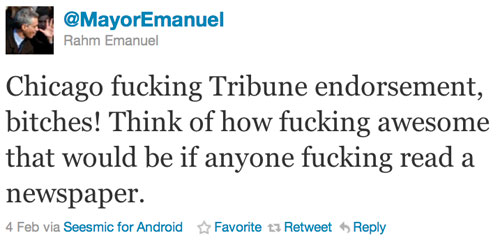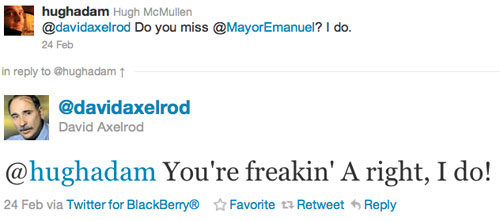Now that former White House Chief of Staff Rahm Emanuel was recently elected mayor, the man behind the @MayorEmanuel Twitter feed has been revealed in a piece in The Atlantic.
The man is Dan Sinker, journalism professor at Columbia College in Chicago and founder of the now defunct zine, Punk Planet.
In Alexis Madrigal’s piece for The Atlantic, Sinker’s @MayorEmanuel is portrayed as an evolution in Sinker’s approach to journalism and story-telling:
After Punk Planet’s sad demise — mostly due to distribution problems, Sinker says — Sinker received a Knight Fellowship in Journalism at Stanford. He used the time to study how to deliver journalism in a world of mobile device ubiquity. In 2009, he launched CellStories.net, which puts out one story per day exclusively for mobile devices. And he landed a gig teaching journalism at Columbia College in downtown Chicago.
As a professor, Sinker focuses on entrepreneurial journalism and independent media. A student in one of his classes described him as down-to-earth, knowledgeable, and interesting. She said he encouraged his students to build businesses around their work, helping underserved groups find places to congregate online. “He’s DIY,” she said and “big on building communities.” Most importantly, in a journalism world drenched in negativity, she said Sinker inspired students because he’s actually positive about the future of media.
I think it was evident early on that whomever was behind this Twitter feed was no idiot. The constant cussing, the rants and the side stories didn’t bely his brilliance, but rather highlighted it. It was obvious that this person knew a lot about Rahm Emanuel, Chicago, politics and how social media works. The @FakeSarahPalin account that emerged in the 2008 election lacked the depth that @MayorEmanuel possessed. It was snarky, and sometimes witty, but didn’t have a cohesive feel. It didn’t feel like an epic, which is how Madrigal describes Sinker’s feed.
Are you catching that? This Twitter feed — delivered in 140-character installments — is being gushed about and being described with words like “epic” and “poem.” This Twitter feed that you can get on your cellphone and that has more “fucks” you can count is — rightfully so — being lauded as a masterpiece.
So, how can we learn from Dan Sinker?
I think we need to be as tapped into our topics as he was tapped into Rahm Emanuel, both as a person and politician. Sinker’s understanding of Chicago was key; who else but a die-hard Chicagoan would know celery salt? (Note: Celery salt is popular with Chicago hot dogs, though I’ve always thought it was gross).
So, knowing your topic thoroughly is a start. But you also need to know your audience. Dan Sinker knew his audience, which was probably a cross-section of Chicagoans, social media enthusiasts and people who appreciate satire. In those three designations, we probably cover young people who laugh at the word “fuck.” Key to knowing the audience is knowing how they use Twitter. Having several posts over the period of a day allowed him to start episodic storylines and introduce characters like Quaxelrod.
Which is I think the third important lesson of this whole thing: have fun with it. Sinker certainly did.
Fundamentally, though, he had an underlying nut graf that can be traced to his punk sensibilities. In Alexis Madrigal’s piece for The Atlantic, Sinker’s view of punk is summed up pretty aptly:
Sinker described the punk rock mindset in his introduction to a 2001 book that collected interviews from the zine. “[Punk] is about looking at the world around you and asking, ‘Why are things as fucked up as they are?'” he wrote. “And then it’s about looking inwards at yourself and asking, “Why aren’t I doing anything about this?”
Joshua Benton at The Nieman Journalism Lab writes that Sinker’s application of the punk ethos in modern times is noteworthy because of the tools he’s using:
But punk is also about the tools you end up doing that “anything” with. The promise of punk is that you don’t need anything fancy to do something great. You don’t need to be Jimmy Page or Steve F’in Howe to play guitar; you just need three chords. You don’t need fancy technique to be an artist; stencils and spray paint will work. And you don’t need a desk in a newsroom to be a journalist; the Xerox machines at your copy shop will do.
Benton points to a video of Dan Sinker shot by Ted Delaney in 2009, in which he says…
Sinker almost gives a two-year-ahead preview of what would become @MayorEmanuel, not to mention a great piece of advice for the future of journalism: Use simple tools and platforms, then breathe life into them. Don’t accept that something basic can’t be used to create something beautiful and creative.
Even something as basic as a box that only takes 140 characters…
…It sums up just about everything good about the DIY web, and it’s a spirit — innovation with simple tools and a little human creativity — that can lead a simple Twitter account to become something beautiful.
Simple can indeed be creative and catch on. It’s worked for The Oatmeal, Hyperbole and a Half and Megan McGlover. Hell, @MayorEmanuel was so popular, even Axelrod misses him.
So do I. Freakin’ right, so do I.


